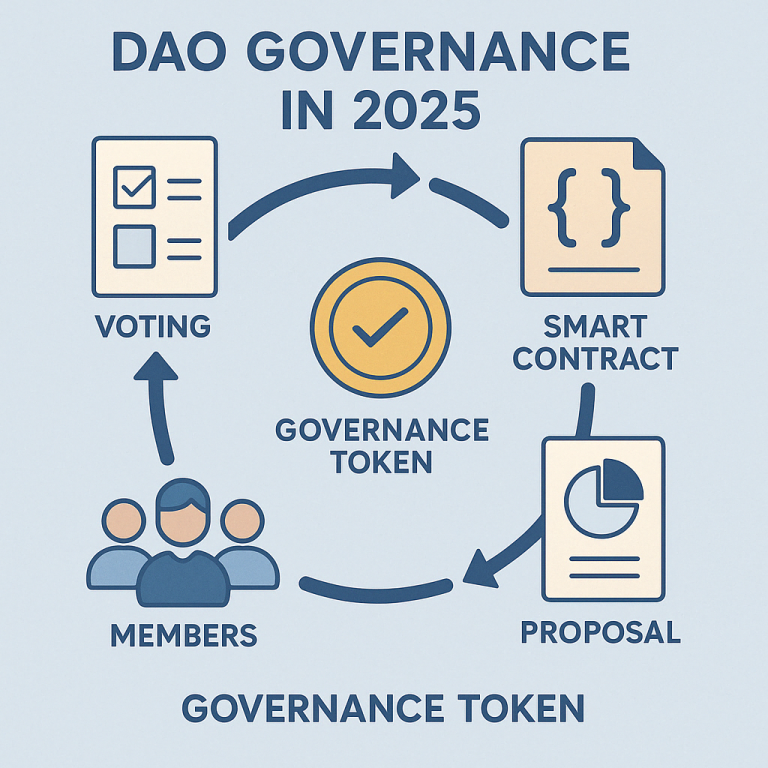Ethereum After $100K Bitcoin: Why ETH Is Still the Heart of Web3 in 2025
Ethereum After $100K Bitcoin: Why ETH Is Still the Heart of Web3 in 2025
When Bitcoin surged past the symbolic $100,000 mark in early 2025, it dominated headlines and market sentiment. Crypto traders cheered, skeptics watched cautiously, and institutions rushed to adjust their forecasts. Yet amid the excitement, one quiet truth remained unchanged: Ethereum is still the heart of Web3.
While Bitcoin captures attention as digital gold and a hedge against inflation, Ethereum powers the decentralized infrastructure that underpins a new generation of internet services, finance tools, and digital economies. As the Web3 revolution accelerates, Ethereum’s role becomes more critical than ever.
1. Ethereum 2025: Still the Beating Heart of Web3

Bitcoin and Ethereum have always represented two distinct philosophies within the blockchain world. Bitcoin is optimized for security, scarcity, and long-term storage of value. Ethereum, by contrast, was designed as a programmable blockchain — a platform for smart contracts, decentralized applications (dApps), and tokenized assets.
In 2025, this difference becomes more pronounced. Bitcoin’s utility remains narrow, even as it gains global acceptance. Ethereum, meanwhile, is integrated into everything from decentralized finance (DeFi) protocols to token standards, decentralized identity systems, and even enterprise supply chains.
As Bitcoin climbs, Ethereum builds.
2. Ethereum’s Ecosystem Dynamics
The divergence in utility between Bitcoin and Ethereum is further evident in their ecosystem development. While Bitcoin maintains a minimalist protocol focused on security, Ethereum fosters a collaborative, open-source innovation hub powered by community-driven upgrades.
The Ethereum Improvement Proposal (EIP) process allows developers to implement upgrades transparently. Ethereum’s shift to Proof-of-Stake has significantly reduced energy usage and enhanced scalability, making it more sustainable and future-ready.
3. Ethereum’s Role in the Web3 Stack
What sets Ethereum apart in 2025 is its position as the foundational layer of the Web3 movement. It enables:
- Community-owned DAOs with democratic voting systems
- Tokenized assets and real-world asset on-chain representation
- Cross-chain interoperability with other ecosystems like Solana and Cosmos
- Decentralized digital identity and zero-knowledge privacy protocols
In short, while BTC remains a passive hedge, ETH is infrastructure — dynamic, evolving, and essential for builders, creators, and investors.
4. The Institutional Case for Ethereum

In 2025, Ethereum has quietly become the platform of choice for institutions exploring blockchain integration. Companies like ConsenSys and protocols like Aave and MakerDAO have matured to offer institutional-grade lending, insurance, and liquidity.
Enterprise adoption is on the rise — with Fortune 500 companies issuing bonds, tokenizing supply chains, and piloting stablecoins directly on Ethereum and Layer 2 networks like Arbitrum and Optimism.
5. ETH as Ultra-Sound Money
In Ethereum 2025, following the Merge and EIP-1559, Ethereum transitioned to a deflationary model. Gas fees are partially burned, reducing ETH’s total supply. As a result, ETH now competes as a deflationary monetary asset — programmable and secure, with actual economic utility.
For many analysts, ETH represents a stronger macro investment thesis than Bitcoin, due to its integration in DeFi, NFT infrastructure, and Layer 2 networks.
Part 2: Ethereum’s Core Stack — DeFi, NFTs, and AI
Ethereum powers more than token transfers — it fuels the engine of Web3 through a vast network of decentralized applications. In 2025, it underpins DeFi, NFT economies, and increasingly intersects with artificial intelligence. Each of these layers builds on Ethereum’s infrastructure and solidifies its role as the operating system of the decentralized internet.
1. DeFi: Ethereum’s Financial Backbone
Decentralized finance (DeFi) began as an experiment but has now evolved into a serious alternative to traditional finance. Built on Ethereum, platforms like Aave, Uniswap, and Compound enable users to lend, borrow, and earn yields without middlemen.
By 2025, DeFi protocols on Ethereum manage tokenized real-world assets, such as carbon credits, invoices, and property. This shift toward institutional-grade DeFi brings legitimacy and new use cases. With decentralized governance, automated market makers, and collateralized lending, Ethereum has become the financial layer of the open internet.
2. NFTs: Infrastructure, Not Just Art

Non-fungible tokens (NFTs) once known for art sales and collectibles have now matured into digital infrastructure. On Ethereum, NFTs enable:
- Proof of ownership for in-game assets and metaverse identities
- Access control for private groups, token-gated content, or affiliate commerce
- Decentralized identity (DID) frameworks — privacy-preserving login and reputation systems
Standards like ERC-721, ERC-1155, and new proposals such as ERC-6551 (token-bound accounts) position Ethereum as the leader in digital rights management.
Major brands like Yuga Labs, Nike, and Starbucks use Ethereum for loyalty systems, collectibles, and immersive consumer experiences. In Ethereum 2025, NFTs go beyond collectibles — becoming gateways to digital identity and ownership.
3. Ethereum Meets AI
The next wave of Ethereum adoption is happening at the intersection of AI and blockchain. In 2025, projects are using Ethereum to:
- Tokenize and license AI training datasets (e.g., Ocean Protocol)
- Verify content provenance for AI-generated media (deepfake detection, audit logs)
- Distribute royalties for AI-generated art and creative content
Smart contracts powered by Ethereum now execute decisions based on AI signals — for instance, in real-time risk assessment, algorithmic insurance, or DAO governance automation.
By combining transparent blockchain logic with dynamic AI decision-making, Ethereum is at the frontier of ethical automation and human-centered machine intelligence.
4. Ethereum as Web3’s Operating System
With support for thousands of decentralized applications and dozens of standards, Ethereum functions like a programmable layer of the internet — enabling anyone to launch tokens, run DAOs, mint NFTs, and coordinate trustlessly.
Through its smart contract platform and ecosystem tools, Ethereum remains unmatched in composability, developer adoption, and community innovation.
Part 3: Ethereum’s Strategic Edge — Scaling, Governance, and Adoption

Ethereum’s long-term viability goes far beyond its technology stack — it lies in its ability to adapt, coordinate, and evolve. In 2025, Ethereum stands apart from other chains not just by performance, but by vision, culture, and governance. This section explores why Ethereum continues to lead, even as competition grows fiercer.
1. Layer 2 Networks: Scaling for the Masses
Ethereum’s most important structural upgrade is the widespread adoption of Layer 2 (L2) solutions like Arbitrum, Optimism, Base, and zkSync.
These L2s offload transactions from the Ethereum mainnet, offering cheaper and faster experiences without sacrificing decentralization. In 2025, L2 networks host everything from social apps to games, NFT minting, and even tokenized asset markets — all while anchoring security on Ethereum L1.
2. ETH as Ultra-Sound Money
The transformation of ETH into a deflationary, yield-generating asset continues. Following The Merge and EIP-1559, Ethereum’s supply has been decreasing as gas fees are burned.
With staking rewards replacing miner incentives and Layer 2 demand growing, ETH is now perceived as “ultra-sound money” — useful, scarce, and integrated across nearly every DeFi, NFT, and DAO product in the ecosystem.
3. Institutional Integration
In Ethereum 2025, major institutions have taken Ethereum seriously. In 2025, platforms like JPMorgan Onyx, Goldman Sachs, and governments exploring Ethereum-based CBDCs signal rising enterprise trust.
Tokenized treasury bonds, carbon markets, and supply chain logistics are already being deployed on Ethereum infrastructure. Enterprises value its maturity, tooling, and strong developer support.
4. Decentralized Governance in Action
Unlike centralized blockchains, Ethereum governance is community-led. Changes are discussed and approved via Snapshot votes, EIP proposals, and developer consensus. There’s no CEO or foundation that can make unilateral protocol decisions.
This resilience is why Ethereum continues to evolve while others fork, freeze, or fragment. The community ensures Ethereum adapts without compromising principles.
5. Innovation and Interoperability
Ethereum’s roadmap includes rollup-centric scaling, data sharding, stateless clients, and greater interoperability with Cosmos, Polkadot, and Bitcoin via bridges.
Its flexibility to plug into other networks ensures Ethereum won’t be isolated — instead, it will act as the programmable core of a modular, multi-chain Web3 future.
Conclusion: Ethereum’s Long Game
In a crypto landscape of hype and fast-moving trends, Ethereum continues to play the long game. Its strategic combination of scalability, monetary policy, open governance, and real-world adoption makes it a foundational layer that Web3 is built on — and will be for years to come.

FAQs: Ethereum vs Bitcoin in 2025
Is Ethereum still relevant after Bitcoin hits $100K?
Yes. While Bitcoin is seen as digital gold, Ethereum remains Web3’s infrastructure — powering DeFi, NFTs, and AI innovation.
What makes Ethereum 2025 unique?
Ethereum offers smart contracts, decentralized governance, and Layer 2 scaling — making it more than a cryptocurrency.
Will Ethereum surpass Bitcoin in market cap?
It’s possible long-term. Ethereum’s utility and deflationary mechanics give it strong fundamentals beyond price speculation.
How does Ethereum benefit from AI integration?
Smart contracts can automate AI-driven actions, while tokenized data sets support fair access and traceability on-chain.
What are the top Ethereum projects in 2025?
Uniswap, Arbitrum, Optimism, Aave, and new AI-integrated tools lead Ethereum’s active ecosystem in 2025.
Is ETH a better long-term investment than BTC?
That depends on goals. BTC is seen as a macro hedge
✅ Explore More:
- NFT Utility and Monetization in 2025
- DAO Governance Trends You Shouldn’t Miss
- Web3 x AI: Use Cases and Risks
🚀 Connect With Us
📬 Stay Updated on Web3 Careers
Join our newsletter to get weekly tips, job openings, and tools for Web3 professionals.
💸 Start Earning with CryptoNav
Explore top crypto platforms, claim welcome bonuses, and support our work through affiliate links:






